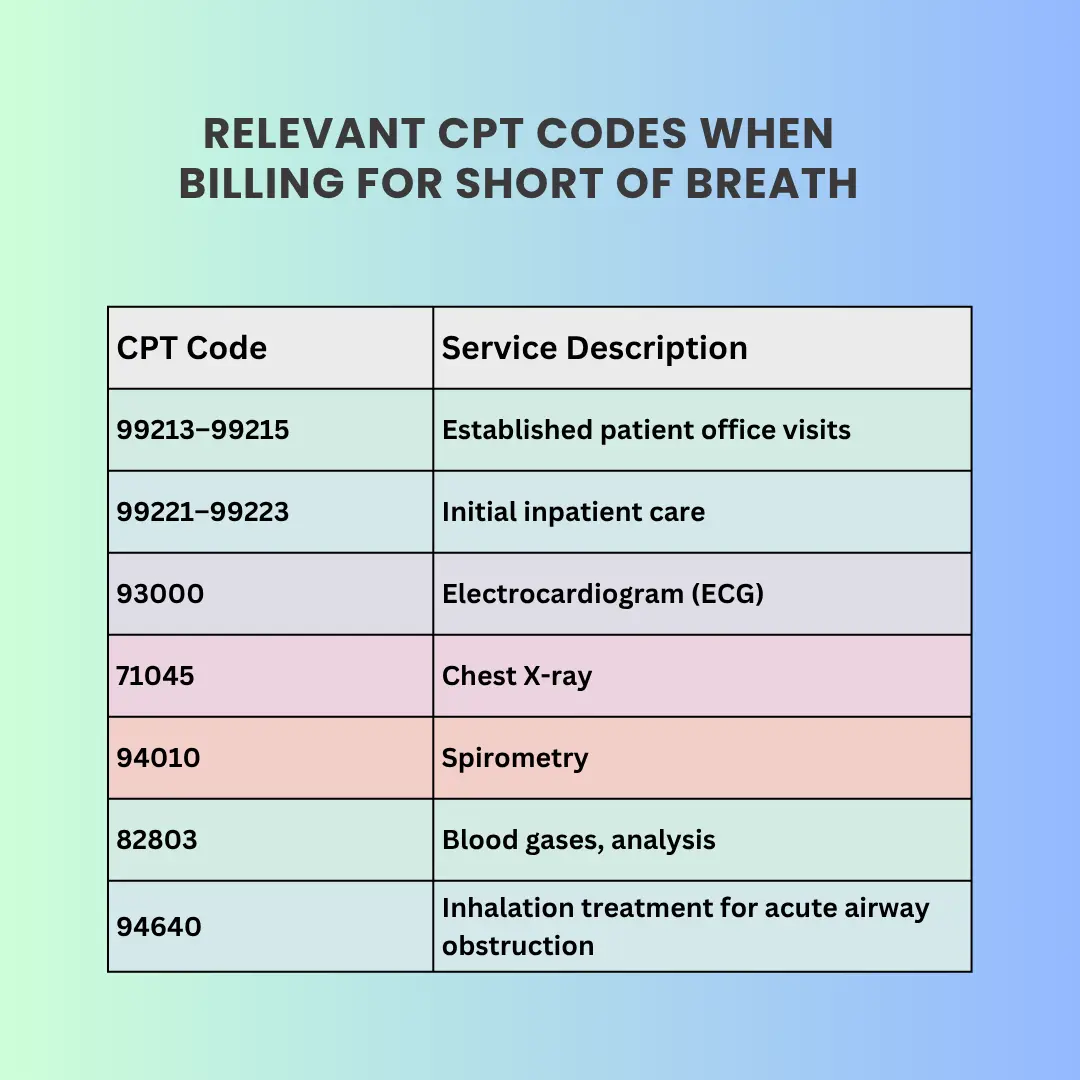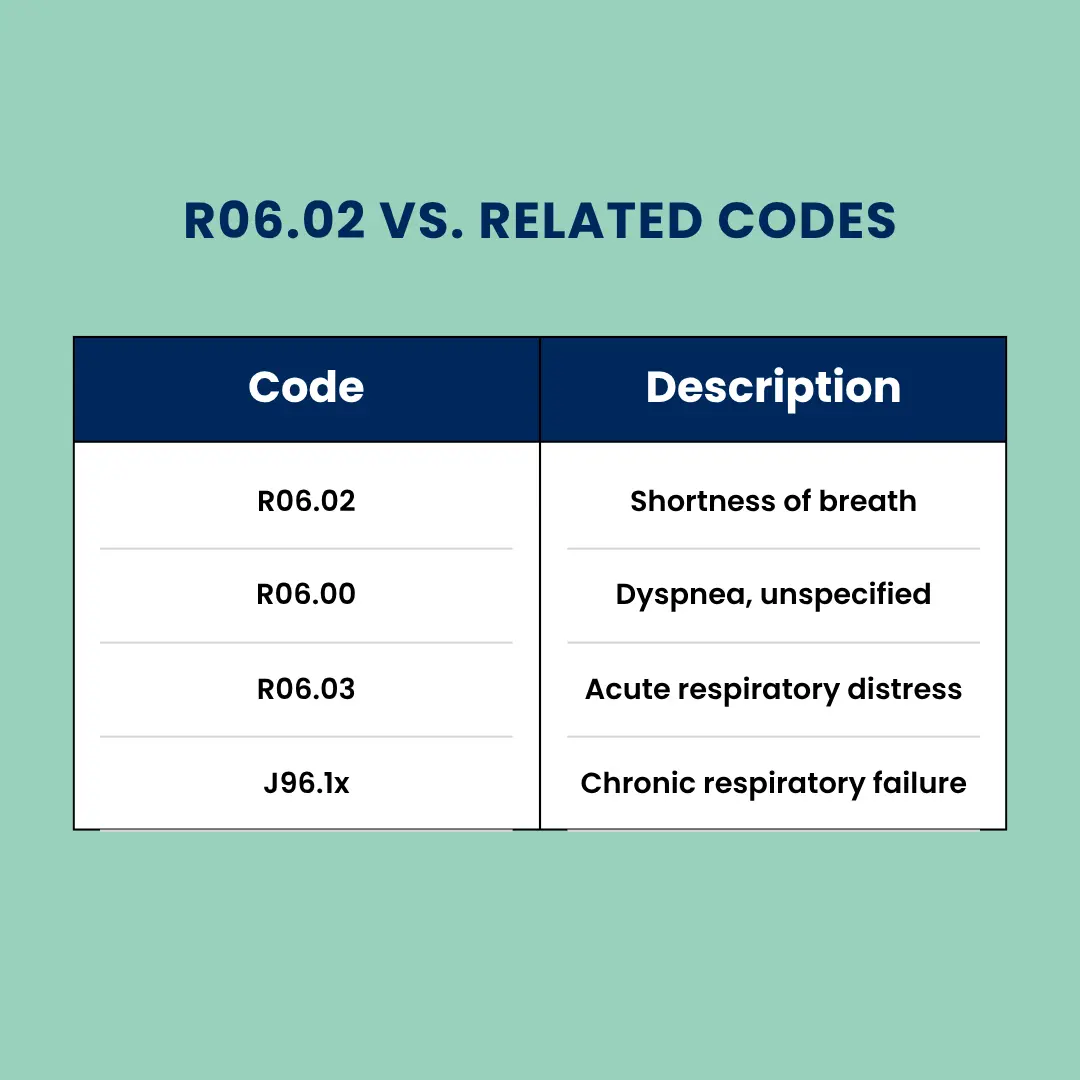Shortness of breath also referred to as dyspnea is one of the most common clinical presentations in both inpatient and outpatient settings. While it may seem like a straightforward symptom, assigning the correct ICD-10 code for short of breath requires careful attention to documentation specificity, clinical context, and payer guidelines.
Incorrect coding can lead to claim denials, reimbursement delays, and compliance issues especially if the underlying cause of the symptom is known but not coded. This article provides a technical yet accessible guide for coding R06.02, along with supporting CPT links, denial prevention strategies, and best practices.
Understanding Shortness of Breath in Clinical Terms
Shortness of breath (SOB) is a subjective feeling of not getting enough air, often described by patients as difficulty breathing, tightness in the chest, or rapid breathing. It can be:
- Acute (e.g., asthma attack, pneumonia, pulmonary embolism)
- Chronic (e.g., COPD, heart failure, interstitial lung disease)
- Exertional (occurring with physical activity)
- At rest (often indicating more severe pathology)
From a coding perspective, the context matters because ICD-10 rules require you to code the most specific condition supported by documentation.
Primary ICD-10 Code for Shortness of Breath
| ICD-10 Code | Description | When to Use |
|---|---|---|
| R06.02 | Shortness of breath | Used when SOB is documented without a confirmed underlying diagnosis |
| R06.00 | Dyspnea, unspecified | Use only if the provider has documented "dyspnea" but no further qualifiers |
| R06.09 | Other forms of dyspnea | Use for specified dyspnea types not covered by R06.02 |
| R06.03 | Acute respiratory distress | Use if clearly documented as such |
| R06.01 | Orthopnea | SOB when lying flat |
📌 Important: If the provider has diagnosed a specific condition causing SOB (e.g., asthma, CHF), code the condition first instead of, or in addition to the symptom.
Clinical Documentation Requirements for R06.02
Accurate coding depends on clear, detailed documentation. When coding ICD-10 code for short of breath, provider notes should ideally include:
- Onset and duration (acute vs. chronic)
- Triggers (exertion, allergens, rest)
- Associated symptoms (wheezing, chest pain, fever)
- Objective findings (oxygen saturation, respiratory rate, ABG results)
- Any confirmed or suspected underlying cause
- Response to treatment
Example of strong documentation:
"Patient presents with acute shortness of breath on exertion for 2 days, O₂ saturation 88% on room air, improved with supplemental oxygen. No chest pain, denies cough. CXR pending. Suspect pneumonia vs. COPD exacerbation."
This level of detail helps determine whether R06.02 is appropriate or whether the cause should be coded instead.
Common Coding Errors with R06.02
| Error | Impact |
|---|---|
| Using R06.02 when a more specific diagnosis is available | Leads to unspecified coding and potential denials |
| Coding both R06.02 and a definitive diagnosis without medical necessity | May cause redundancy or trigger payer edits |
| Failing to code comorbidities like COPD or CHF that explain SOB | Missed DRG optimization and risk adjustment |
| Omitting objective clinical evidence (O₂ saturation, ABGs) in notes | Increases denial risk during medical review |
| Confusing R06.02 with codes for respiratory failure | Could misrepresent severity and alter DRG |
💡 Pro Tip: Always check if SOB is a primary symptom or a manifestation of a confirmed condition sequence accordingly.
Relevant CPT Codes When Billing for Shortness of Breath
While R06.02 is the diagnosis code, CPT codes capture the services performed to evaluate or manage the symptom.

Coding tip: Always ensure the CPT code’s medical necessity is supported by the R06.02 diagnosis (or the underlying condition).
Payer Policy Insights & Compliance Notes
Many payers scrutinize symptom codes like R06.02 to ensure medical necessity.
- Medicare: May require additional documentation if used as the primary diagnosis without an identified cause.
- Commercial insurers: Often expect SOB to be linked to a workup (e.g., imaging, labs) or underlying disease code.
- Risk adjustment models: SOB alone rarely adjusts risk scores coexisting conditions must be coded.
When NOT to Use R06.02
Do not use ICD-10 code for short of breath when:
- The cause is confirmed (e.g., asthma, pneumonia)
- The provider documents "respiratory distress" with specific criteria (use R06.03)
- The symptom is part of a post-operative or injury code scenario (use combination codes
Best Practices for Avoiding Denials
- Query Providers Early – If documentation is vague, request clarification before claim submission.
- Code to the Highest Specificity – Use subcategories or cause-specific codes when available.
- Link Symptoms and Diagnoses – When SOB is related to another condition, link the codes.
- Ensure Test Results Are in the Chart – Objective data strengthens claim defensibility.
R06.02 vs. Related Codes

How Pro-MBS Ensures Precision in Shortness of Breath (SOB) Coding
Accurate assignment of the ICD-10 code for shortness of breath requires a detailed review of clinical documentation to confirm completeness and specificity. Coders must verify that essential diagnostic details such as onset, duration, triggers, associated symptoms, and objective data like oxygen saturation or arterial blood gas results are clearly documented. This precision prevents reliance on unspecified codes and ensures compliance with ICD-10-CM guidelines.
Payer-specific coding rules are applied to minimize denial risk and support optimal reimbursement. This includes validating CPT–ICD linkage for medical necessity, issuing documentation improvement queries when gaps are identified, and optimizing DRG assignment when SOB is linked to high-acuity conditions such as acute heart failure or pulmonary embolism. By integrating clinical correlation, compliance requirements, and revenue cycle considerations, coding accuracy is strengthened while protecting claim integrity.



